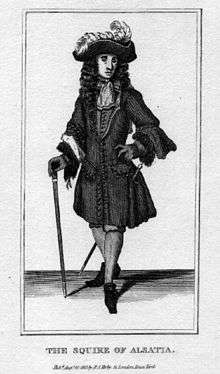Alsatia

Alsatia was the name given to an area lying north of London's River Thames once privileged as a sanctuary. It spanned from the Whitefriars monastery to the south of the west end of Fleet Street and adjacent to the Temple. Between the fifteenth and seventeenth centuries it was proofed against all but a writ of the Lord Chief Justice or of the Lords of the Privy Council,[1] becoming a refuge for perpetrators of every grade of crime.
Name
It was named after the ancient name for Alsace, a region outside legislative and juridical lines, and first appeared in print in the 1688 play by Thomas Shadwell, The Squire of Alsatia. To this day it remains used as a term depicting an area beyond the law.[2]
As a sanctuary
The execution of a warrant in Alsatia, if at any time practicable, was attended with great danger, as all united in a maintenance in common of the immunity of the place. It was one of the last places of sanctuary used in England, abolished by Act of Parliament named The Escape from Prison Act in 1697[1] and a further Act in 1723. Eleven other places in London were named in the Acts (The Minories, The Mint, Salisbury Court, Whitefriars, Fulwoods Rents, Mitre Court, Baldwins Gardens, The Savoy, The Clink, Deadmans Place, Montague Close, and Stepney).[1]
In the reign of Edward I., a certain Sir Robert Gray, moved by qualms of conscience or honest impulse, founded on the bank of the Thames, east of the well-guarded Temple, a Carmelite convent, with broad gardens, where the white friars might stroll, and with shady nooks where they might con their missals. Bouverie Street and Ram Alley were then part of their domain, and there they watched the river and prayed for their patrons' souls. In 1350 Courtenay, Earl of Devon, rebuilt the Whitefriars Church, and in 1420 a Bishop of Hereford added a steeple. In time, greedy hands were laid roughly on cope and chalice, and Henry VIII., seizing on the friars' domains, gave his physician—that Doctor Butts mentioned by Shakespeare—the chapter-house for a residence. Edward VI.—who, with all his promise, was as ready for such pillage as his tyrannical father—pulled down the church, and built noblemen's houses in its stead. The refectory of the convent, being preserved, afterwards became the Whitefriars Theatre. The mischievous right of sanctuary was preserved to the district, and confirmed by James I., in whose reign the slum became jocosely known as Alsatia— from Alsace, that unhappy frontier then, and later, contended for by French and Germans—just as Chandos Street and that shy neighbourhood at the north-west side of the Strand used to be called the Caribbee Islands, from its countless straits and intricate thieves' passages. The outskirts of the Carmelite monastery had no doubt become disreputable at an early time, for even in Edward III.'s reign the holy friars had complained of the gross temptations of Lombard Street (an alley near Bouverie Street). Sirens and Dulcineas of all descriptions were ever apt to gather round monasteries. Whitefriars, however, even as late as Cromwell's reign, preserved a certain respectability; for here, with his supposed wife, the Dowager Countess of Kent, Selden lived and studied.
— According to Walter Thornbury, in his 1878 book Old and New London[3]
References
- 1 2 3

- ↑ Lashmar, Paul (27 May 2007). "Law Lords slam crime agency for freezing UMBS payments". London: The Independent. Archived from the original on 1 October 2007. Retrieved 2010-05-30.
- ↑ Thornbury, Walter (1878). "Chapter XVII: Whitefriars". Old and New London: Volume 1. London: Cassell, Petter & Galpin. pp. 182–199. Retrieved 25 May 2017 – via British History Online.